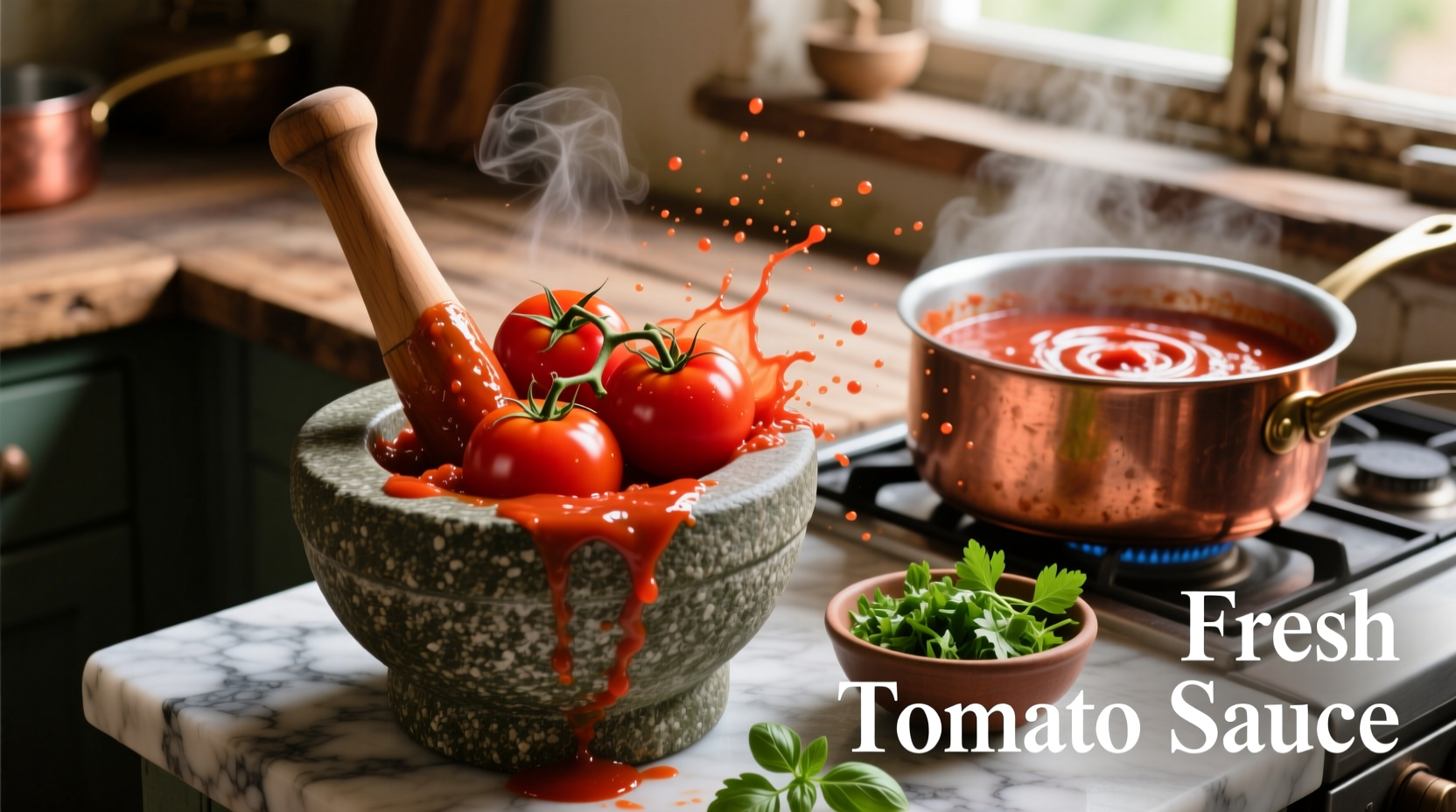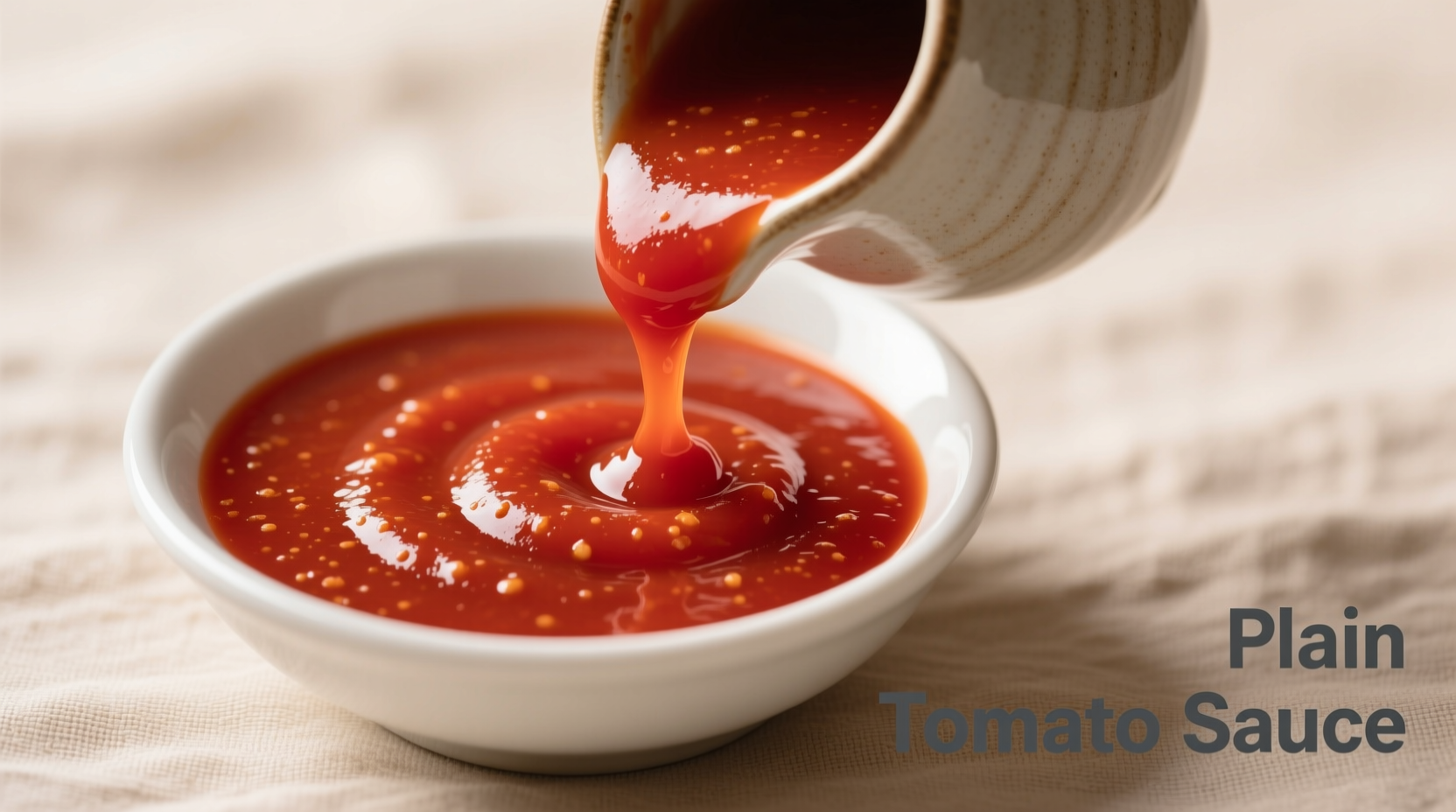Plain tomato sauce is an unseasoned, smooth tomato product made from cooked and strained tomatoes, containing only tomatoes and sometimes a small amount of citric acid or calcium chloride for preservation. Unlike marinara or pasta sauces, it contains no herbs, spices, or additional ingredients, making it a versatile cooking foundation for countless dishes.
What Exactly Is Plain Tomato Sauce?
When you reach for that can labeled "plain tomato sauce" at the grocery store, you're grabbing a culinary blank canvas. This essential pantry staple consists of tomatoes that have been cooked, strained to remove seeds and skin, and lightly seasoned—typically with only salt and sometimes citric acid for pH balance. Unlike its more flavorful cousins like marinara or arrabbiata, plain tomato sauce contains no garlic, onions, herbs, or other seasonings.
The USDA defines plain tomato sauce as "a liquid product prepared by cooking tomatoes, with or without the addition of salt, citric acid, or calcium chloride." This simple composition makes it fundamentally different from tomato paste (which is concentrated) or ready-to-eat pasta sauces (which are fully seasoned).
| Tomato Product | Consistency | Ingredients | Best Uses |
|---|---|---|---|
| Plain Tomato Sauce | Thin, pourable liquid | Tomatoes, salt, citric acid | Base for sauces, soups, stews |
| Tomato Paste | Thick, concentrated paste | Tomatoes only | Flavor enhancer, small amounts |
| Marinara Sauce | Medium thickness | Tomatoes, garlic, herbs, olive oil | Ready-to-use pasta sauce |
| Tomato Puree | Thicker than sauce, thinner than paste | Tomatoes only | Cooking base, slightly more concentrated |
Why Plain Tomato Sauce Belongs in Your Pantry
Professional chefs and home cooks alike keep plain tomato sauce on hand because of its incredible versatility. Without pre-added seasonings, it gives you complete control over flavor development in your dishes. The FDA's Center for Food Safety and Applied Nutrition confirms that plain tomato sauce maintains a consistent pH level (typically 4.1-4.6), which is crucial for both food safety and proper flavor development in cooked dishes.
According to USDA FoodData Central, a 100g serving of plain tomato sauce contains approximately 35 calories, 1.3g protein, 7.5g carbohydrates, and provides 20% of your daily vitamin C needs. Its natural acidity makes it an excellent base that enhances other flavors without overwhelming them.

Top 5 Culinary Applications for Plain Tomato Sauce
Understanding where plain tomato sauce shines can transform your cooking. Here's how to maximize this pantry essential:
1. Custom Pasta Sauce Foundation
Start with plain tomato sauce as your base, then build your ideal flavor profile. Sauté garlic and onions in olive oil, add the plain sauce, and customize with fresh basil, oregano, or red pepper flakes to match your meal. This approach gives you restaurant-quality control over seasoning without the sodium and preservatives found in many pre-made sauces.
2. Flavorful Soup and Stew Base
When making minestrone, vegetable soup, or hearty stews, plain tomato sauce adds depth and richness without introducing competing flavors. Its smooth texture blends seamlessly with other ingredients, creating a cohesive flavor profile that complements rather than dominates.
3. Homemade Pizza Sauce
For pizza enthusiasts, plain tomato sauce provides the perfect starting point. Simply mix with a touch of garlic powder, dried oregano, and a pinch of sugar to balance acidity. Unlike commercial pizza sauces that can be overly seasoned, this approach lets you control the flavor intensity to match your toppings.
4. Braising Liquid for Proteins
When braising chicken, pork, or beef, plain tomato sauce creates a flavorful cooking liquid that tenderizes while adding subtle tomato richness. The absence of pre-added seasonings means you can perfectly match the sauce to your protein—add smoked paprika for pork, cumin for beef, or fresh herbs for chicken.
5. Emergency Sauce Rescue
Ran out of your favorite sauce? Plain tomato sauce can save the day. Thin it with broth for a quick soup base, mix with cream for a creamy tomato sauce, or blend with roasted red peppers for a sophisticated dipping sauce. Its neutral profile makes it incredibly adaptable in cooking emergencies.
When Plain Tomato Sauce Isn't the Right Choice
While versatile, plain tomato sauce has limitations. It's not ideal when you need immediate flavor—think quick weeknight meals where time is limited. In these cases, a ready-made marinara might be more practical. Additionally, for dishes requiring intense tomato concentration like some Italian ragus, tomato paste provides better depth with less liquid content.
Food science research from the Culinary Institute of America shows that plain tomato sauce's water content (typically 92-94%) means it requires additional reduction time compared to tomato paste when building concentrated flavors. Understanding this helps you choose the right product for your cooking timeline.
DIY Plain Tomato Sauce: Simple Homemade Version
Making your own plain tomato sauce ensures freshness and lets you control quality. Here's a professional chef's approach:
- Ingredients: 2.5 lbs ripe Roma tomatoes, 1 tsp salt, 1 tbsp lemon juice or citric acid (optional)
- Process: Score tomatoes, blanch in boiling water for 30 seconds, transfer to ice water, then peel. Remove cores and seeds. Simmer tomatoes with salt for 20-25 minutes until broken down. Pass through a food mill to remove skins and seeds.
- Storage: Cool completely before storing in airtight containers. Keeps refrigerated for 5 days or frozen for 6 months.
This homemade version avoids the preservatives found in many commercial products while delivering superior fresh tomato flavor. The National Center for Home Food Preservation recommends adding citric acid (1 tbsp per quart) when canning to ensure proper acidity for safe shelf storage.
Frequently Asked Questions
Can I substitute tomato paste for plain tomato sauce?
Yes, but you'll need to dilute it. Mix 1 part tomato paste with 2 parts water to approximate plain tomato sauce consistency. This substitution works well when you need immediate acidity and tomato flavor without the water content of regular sauce.
How long does opened plain tomato sauce last in the refrigerator?
According to FDA food safety guidelines, opened plain tomato sauce maintains quality for 5-7 days when stored in a covered container in the refrigerator at or below 40°F (4°C). Always check for off odors, mold, or unusual texture before using.
Is plain tomato sauce gluten-free?
Yes, authentic plain tomato sauce contains only tomatoes and salt, making it naturally gluten-free. However, always check labels as some commercial varieties may include thickeners or additives that contain gluten, especially in 'style' sauces that mimic plain tomato sauce.
Can I use plain tomato sauce in place of tomato puree?
Yes, but with adjustments. Tomato puree is slightly thicker than plain tomato sauce. For recipes requiring puree, simmer plain tomato sauce uncovered for 10-15 minutes to reduce and thicken it to the proper consistency before using.
Why does plain tomato sauce sometimes separate in the can?
This natural separation occurs because plain tomato sauce contains no stabilizers or thickeners. The liquid ( serum ) separates from the thicker tomato solids. Simply stir well before using—this doesn't indicate spoilage. The USDA confirms this is normal for minimally processed tomato products.











 浙公网安备
33010002000092号
浙公网安备
33010002000092号 浙B2-20120091-4
浙B2-20120091-4